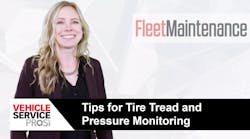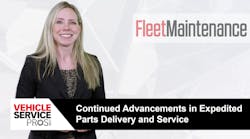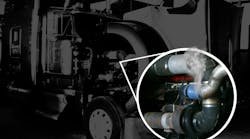Since 2007, all Class 8 tractors in the U.S. have come equipped with a diesel particulate filter to help with filtering out soot and particulate matter from the exhaust system of a vehicle. Even after more than a decade of exposure to DPFs, and the aftertreatment system, there still seems to be an industry-wide frustration and confusion with these systems. Redline Emission Products’ Wayne Cochrane talks about these concerns, and provides guidance on how to tackle DPF cleaning and replacement.
Transcription of interview:
Erica Schueller, Fleet Maintenance: Hello and welcome to VSP News: Uptime Update. I am your host Erica Schueller, Editor-in-Chief of Fleet Maintenance magazine, covering all maintenance, all vehicle classes, all management, all the time.
Since 2007, all Class 8 tractors in the U.S. have come equipped with a diesel particulate filter to help with filtering out soot and particulate matter from the exhaust system of a vehicle. Even after more than a decade of exposure to DPFs, not to mention the vehicle’s aftertreatment system in general, there still seems to be an industry-wide frustration and confusion with these systems.
We talked with Wayne Cochrane, national sales manager for Redline Emission Products, about these concerns. He provided us with some guidance on how to tackle DPF cleaning and replacement. First, we covered some current examples of challenges that fleets face with DPFs.
Wayne Cochrane, Redline Emission Products: The frustration is very real. I think it comes from the fact that fleets are not fully adapted to the system’s needs. We see two big issues: the fleet’s desire to run the trucks as they always have. The new emissions systems require more attention and maintenance than they’re accustomed to.
The second issue is that in the past, many engine issues that developed may have only tripped an engine light and caused excess smoke. But the drivers were able to keep driving.
Now the emissions systems will capture all of that smoke in the diesel particulate filter. Unchecked, it can down the truck. The analogy we use is to think of the DPF like a trash can: the faster you pour garbage in, the faster it will fill up.
An engine issue that causes excess smoke can fill the DPF up to 50 times quicker than under a normal duty cycle, defeating the regeneration technology and causing the engine to derate.
Derates also occur with simple items like exhaust leaks and plugged air intake systems. These also effect the DPF.
Fleets need to understand that their duty cycles vary with application. If, for example, you have 10 vehicles and five of them are on-highway and five of them are inner city, the duty cycles will be very different and the DPF maintenance requirements will be very different.
The inner city vehicles will typically idle much more and as a result the DPFs will fill up quicker and require servicing quicker.
If you’re constantly adding fuel, oil, or coolant to an engine, nowadays you need to understand why as these contaminants can often find their way into an emissions system and cause issues.
Schueller, Fleet Maintenance: There are new technologies and processes that can provide insight on the life of the DPF, which allows technicians to make a decision on how to approach servicing the system and determine the life of that filter. Cochrane talks about the tools available, and steps the industry is taking to standardize these processes.
Cochrane, Redline: OBD, X-rays, borescopes, and other tools are available to service the DPFs. Some are very expensive and out of reach for the average fleet.
The Technology & Maintenance Council (TMC) recently began a taskforce to develop recommended practices for DPF cleanings. The goal is to have a document that the average fleet can reference with real-world procedures such as weigh, flow, pin drop, light, and visual tests.
We want fleets to be able to determine if a filter is clean once they receive it back. If I was to buy a truck – new or used – I would clean and flow test the filter prior to putting that vehicle in service so down the road I have a benchmark to compare the filter against.
It was this concept that gave us the idea to add a “born-on” weight to the DPFs we sell. We also make flow information available so that, again, you can benchmark your DPF to its lifecycle.
Schueller, Fleet Maintenance: Next, we talked about replacing versus cleaning diesel particulate filters. Cochrane provides details on the different strategies for servicing DPFs.
Cochrane, Redline: There are different strategies for servicing an emissions system. We’ll look at them one by one.
- Cleaning. Either internally, or using an outside vendor. Once the equipment is accounted for, this is the least expensive strategy. You remove the filter, it is taken through a process to safely clean it. We recommend an 8-step process.
The pros are that you can keep your original filter, the unit you know and have a history on.
The cons are that the downtime for the vehicle will take up to several days. Some shops will take a few days. We can generally turn a filter around in 24 hours. This process is best done proactively when a vehicle is in for some type of PM. - Reman filters. This is a more expensive option than cleaning. Usually by a factor of three to four times. This is a process that is largely misunderstood, as the title is misleading. No filter is ever truly remanufactured. It is a cleaned filter that has been determined to be reusable.
The pros are that you simply return a core, and receive a clean filter. There’s little downtime, you simply do a swap.
The cons are that you don’t know the history of the core. You don’t know what duty cycle that filter was exposed to. You don’t know how many times that filter has been cleaned. It also may incur a core charge if the core you’ve turned in is not acceptable. - New OEM filter. A new OEM filter is a safe bet, but it’s the most expensive of the options. And, there may be a core charge involved with that as well.
- Aftermarket OE filter replacements. These are also a great, safe bet. With them, typically the warranties are good and there are no core charges to worry about.
A good DPF cleaning shop will be able to assess a filter fairly quickly to determine whether it is good or bad. Some things to look for include:
- Signs of soot on the outlet side, when removing the filter from the vehicle
- Cracks or signs of damage to the core
- Perform pin tests and other simple tests
Schueller, Fleet Maintenance: DPFs don’t appear to be going away, rather they are getting more complex, so education is key for fleets. Cochrane shares more on the continuing trends we can anticipate with regard to the heavy duty emissions system.
Cochrane, Redline: Since 2007, all heavy duty on-road diesel engines in North America have come with a DPF. As older trucks are phased out and newer trucks are delivered with more advanced emissions systems, your choice in a service provider or cleaning strategy is very important. Fleets need to know how these systems operate so the fleet can have as much uptime as possible.
Aftertreatment issues have become the leading cause of vehicle downtime. Fleets that cannot make a shift in thinking and adopt a routine maintenance schedule for the aftertreatment system, will continue to see a rise in downtime.
The fleets that are progressive and quick to adapt a routine DPF cleaning and understand how to maintain these systems and correctly identify clean DPFs will run circles around their competition and get longer life out of their trucks.
Better understanding and training are key to getting the most uptime from these systems, not only from the techs in your shops, but also your fleet manager, your dispatch teams, and drivers. They all need to understand the signs and consequences of these systems malfunctioning or requiring service.
Schueller, Fleet Maintenance: If you’d like more guidance on developing an aftertreatment service plan, visit the link below.
That’s it for this week’s episode! Thank you for tuning in to VSP News Uptime Update, I’m your host Erica Schueller.
Until our next broadcast, keep up with this, and other industry topics, by visiting us online at VehicleServicePros.com.
Learn more about developing an aftertreatment service plan.


